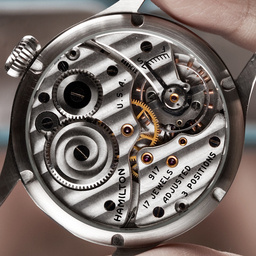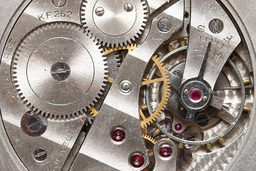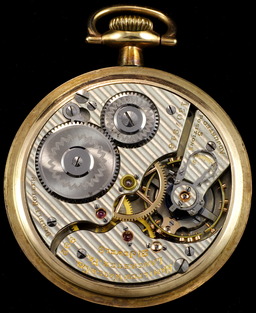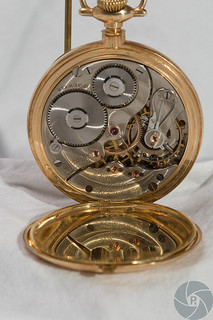"Côtes de Genève" indicates a pattern of stripes produced abrasively. There seems to be much variation in the appearance of (and detailed methods of production of) the stripes themselves, but typically they are produced using rotary motions within the stripes (rather than linear motions).
An idiomatic translation of this term might be "Geneva Stripes" (and that term is often met with in English); a literal translation would be more difficult.
This type of finish is describe in Sermier, Caroline and Giulio Papi. High-End Horological Finishing and Decoration. (Le Locle, CH: Audemars Piguet, 2006): 98-99. Much the same text also appears in material by Sermier on the "watches-lexic" website, at: http://www.watches-lexic.ch/pages/eng/tec/fs_exp21.htm
The watchmaking firm A. Lange & Sohne, located in Glashütte, calls it "Glashütte Ribbing." ( http://www.alange-soehne.com/cms/en/manufactory/superb-craftsmanship/artistic-decorations.html).
Here are two examples from an American watchmaking. The one on the left is a Hamilton 917 from 1945-1947 ("transplanted into a wristwatch case"). The one on the right is the movement from a Hamilton Model 22 ship's chronometer (WWII vintage).


(First image by flickr user "Malenkov in Exile" (Shane Lin) at http://www.flickr.com/photos/shanelin/5366671496/ License: Creative Commons Attribution-NonCommercial 2.0. Second image by Wikimedia Commons user Bonsairolex at http://commons.wikimedia.org/wiki/File:Movement_of_the_hamilton_model_22_world_war_two_time_period_ships_chronometer.jpg. License: Creative Commons Attribution-ShareAlike 3.0 Unported.
Below left is a simpler example. It also displays Snailing (on the mainspring barrel) and Spotting. Below right is another American example, a Hamilton 922L movement (not in its original case).


(Left image by flickr user Monty Hood, at http://www.flickr.com/photos/montyhood/4414773547/ License: Creative Commons Attribution - ShareAlike - Noncommercial 2.0. Right image by flickr user Todd Hall at http://www.flickr.com/photos/tmh9/677919415/ License: Creative Commons Attribution-ShareAlike-Noncommercial 2.0.)
Here are two photographs which give a better view of the underlying pattern of circular arcs within the bars/bands. They are by flickr user GuySie and are of a 1952 vintage Soviet pocket watch movement, a Molnija 3601. (The Soviet watch industry grew out of the American watch industry in the 1920s through the purchase of American watchmaking factories, but developed its methods of production further. See S. V. Tarasov. Technology of Watch Production [Tekhnologiy a chasovogo proizvodstva, 1956] Trans. Albert Baruch. (Jerusalem: Israel Program for Scientific Translations for The Smithsonian Institution and the National Science Foundation, 1964.)) These are both quite large photographs, each about 5000 pixels wide; click for the larger versions and possibly click again to see them at full resolution.


(Both photographs by flickr user GuySie. License: Creative Commons Attribution-ShareAlike 2.0. Locations: http://www.flickr.com/photos/guysie/7483504998/ and http://www.flickr.com/photos/guysie/7483551136/ )
Below are two views of an E. Howard pocket watch owned by (and photographed by) flickr user Phil Romans. Its mainspring barrel is decorated by Snailing. The movement as a whole, however, is decorated by what would seem to be Côtes de Genève in a circular pattern.


(Photographs by flickr user Phil Romans at http://www.flickr.com/photos/mdu2boy/3112347808/in/photostream and http://www.flickr.com/photos/mdu2boy/3111502335/in/photostream License: Creative Commons Attribution - Noncommercial - NoDerivatives.
"Côtes de Genève" designates an abrasive process, but here are two examples which seem almost to have been cut. Both are Chinese watch movements; on the left a 6497 movement (from a Marina Militaire) watch, and on the right a 6498 movement.


(Both photographs by flickr user GuySie. License: Creative Commons Attribution-ShareAlike 2.0. Locations: http://www.flickr.com/photos/guysie/3389999521/ and http://www.flickr.com/photos/guysie/6095265888/ )
The Hamilton 917 photograph by flickr user "Malenkov in Exile" (Shane Lin) is licensed under the Creative Commons Attribution-NonCommercial 2.0 license. Please note that this license is more restrictive than the license of the rest of this present web page; it forbids commercial use (my own use here is noncommercial).
The Hamilton Model 22 photograph by Wikimedia Commons user Bonsairolex is licensed under the Creative Commons Attribution-ShareAlike 3.0 Unported license.
The photograph by flickr user Monty Hood is licensed under the Creative Commons Attribution-ShareAlike-NonCommercial 2.0 license. Please note that this license is more restrictive than the license of the rest of this present web page; it forbids commercial use (my own use here is noncommercial).
The photograph by flickr user Todd Hall is licensed under the Creative Commons Attribution-ShareAlike-NonCommercial 2.0 license. Please note that this license is more restrictive than the license of the rest of this present web page; it forbids commercial use (my own use here is noncommercial).
The photographs by flickr user Phil Romans are licensed under the Creative Commons Attribution-NonCommercial-NoDerivatives 2.0 license. Please note that this license is more restrictive than the license of the rest of this present web page; it forbids commercial use (my own use here is noncommercial) and derivative versions (each use of these images on this site is an exact copy of it as downloaded from flickr).
The photographs by flickr user GuySie are licensed under the Creative Commons Attribution-ShareAlike 2.0 license.
All portions of this document not noted otherwise are Copyright © 2012 by David M. MacMillan and Rollande Krandall.
Circuitous Root is a Registered Trademark of David M. MacMillan and Rollande Krandall.
This work is licensed under the Creative Commons "Attribution - ShareAlike" license. See http://creativecommons.org/licenses/by-sa/3.0/ for its terms.
Presented originally by Circuitous Root®
Select Resolution: 0 [other resolutions temporarily disabled due to lack of disk space]